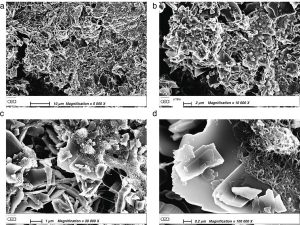
SEM images of PTCLi4-based electrodes comprising 12 wt% of MWCNTs-1 as conductive additive at different magnifications. More information here.
Lithium-based batteries are presently considered to play a decisive role for enabling a fully sustainable energy supply. For this purpose the battery technology itself must become sustainable as well. One way to do this would be to replace the energy-intensive synthesis of inorganic lithium storage materials and switch to organic materials, preferably produced from biomass. However, the charge storage mechanisms of such organic materials are only poorly understood thus far.
In a recent Advanced Sustainable Systems paper, Iordache et al. investigated easy to synthesize organic electrode material tetra-lithium perylene-3,4,9,10-tetracarboxylate (PTCLi4) and thoroughly characterized its performance. Their findings shed light on the charge storage behavior of organic materials thereby eliminating current misconceptions. The presented results do not only contribute to a better understanding of organic active materials in general but moreover provide a great step forward regarding their commercial application and, by this, the realization of fully sustainable secondary batteries in near future.

















